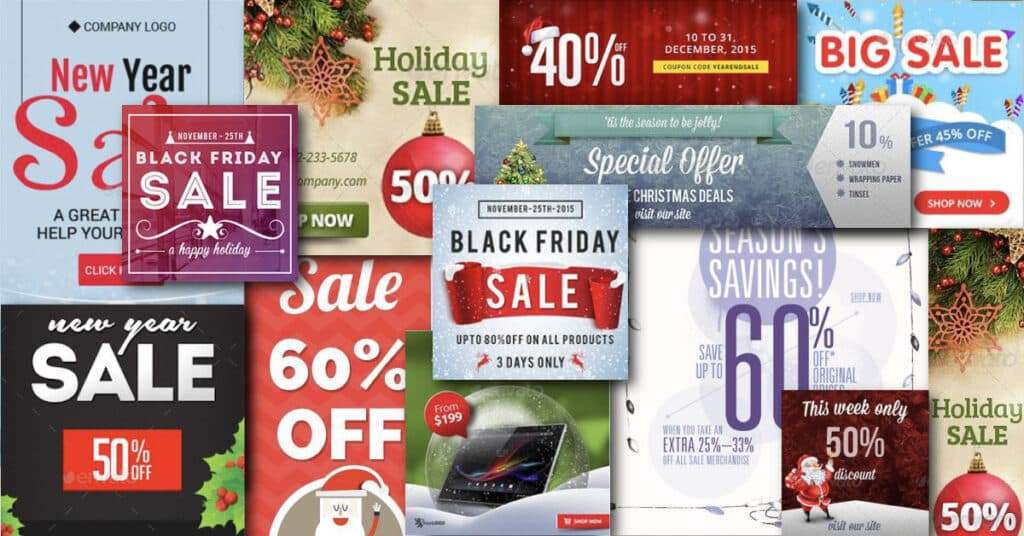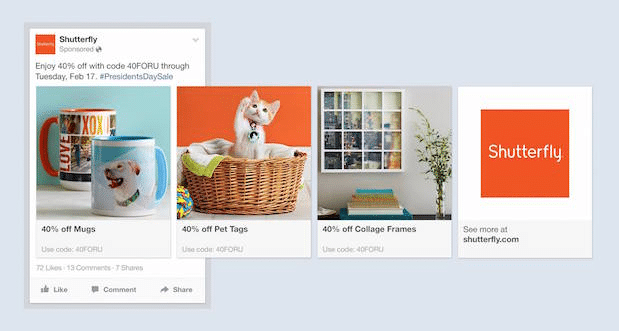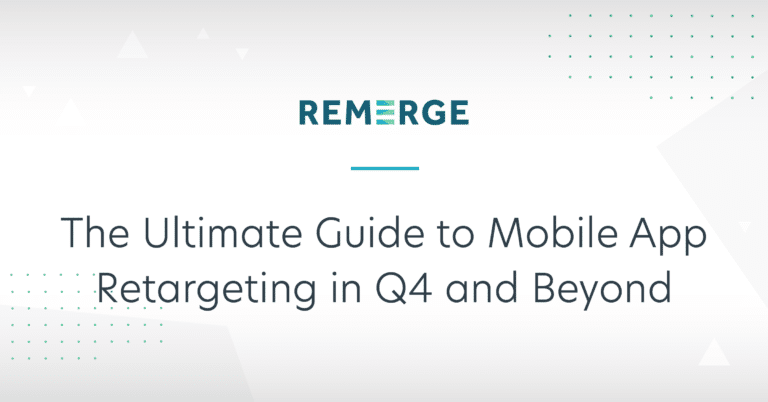Q4 is here already. The holidays are right around the corner. Another year has flown by. You’ve likely been hard at work this year driving growth and have built a solid user base. But now, especially when purchase intent is at its peak, what do you do with these hard-earned users? How can you engage them during this pivotal time of the year? And, most importantly, how can you provide a best in class experience for your mobile users?
The Importance of Retargeting in Q4
It’s time to put your year-long paid and organic user acquisition efforts to good use and think about your retargeting and re-engagement strategy. The end of the year brings increased traffic, and with it an increased need for providing seamless user experiences to optimize for conversions.
But you have to create these seamless experiences in an efficient and effective way. So we asked one of our partners, Tommy Yannopoulos from Remerge, for some tips.
Four Steps to Building a Successful Q4 Retargeting Strategy
1. Start early.
Like any initiative you run, there are inherent inefficiencies in any media buy. Channels need time to optimize against large data sets, which in turn means that not all media spend will immediately achieve your target metrics.
Online holiday shopping (Nov–Dec) revenue in the U.S. last year reached $126B, an increase of 16.5% from 2017. So if you find yourself in a “testing period” during Black Friday, you’ve done something wrong. Seeing results from your retargeting campaigns takes time, and building campaigns that will drive those results takes time.
The best way to maximize the value of all the holidays, especially Black Friday and Cyber Monday, is by knowing what your media mix will look like, and by having an optimized strategy already in place.
2. Engage your users as individuals, not segments.
Intuitively, many of us tend to believe that holiday-themed creative will drive better results. While they’re not necessarily a bad idea, they may not be the best place to devote time and energy. If most advertisers serve holiday-themed banners, is anyone really standing out?

A better approach is one in which you engage your audience as individuals, and in the context of retargeting, personalization is key. How are you speaking to your customers in a way that will drive purchase decisions and add value?
By leveraging dynamic product ads and recommendation engines, you demonstrate to consumers that you’re listening to their experiences in your app. “Listening” in this context primarily manifests itself in two ways:
- showing products in your ads that a user may have left in their cart
- recommending products based on what customers have previously purchased, or searched for
In either instance, you will need to have a product feed, and you will need to pass product IDs dynamically to your ad partner, so they can speak to your consumers intelligently.
Branch and Remerge partner closely together to provide a turnkey solution for advertisers in this regard. On Branch’s end, advertisers can send device IDs with corresponding product IDs in real-time to Remerge, and we in turn tie these IDs to product feeds. Our seamless integration allows advertisers to set up dynamic ads in a process that takes less than an hour. Ultimately, this process then allows advertisers to re-engage their customers in real-time with relevant content.
Tip: Create seamless shopping experiences.
Let’s assume you have dynamic product ads and recommendation engines in place, and you show a consumer an ad based on their experience in the app. If the user clicks that ad, and is not directed to that page, you’ve created a poor shopping experience.
It is tantamount to the success of your campaign that you are able to not only speak to your consumers intelligently, but you are also able to provide them with an experience that is enjoyable. The fastest way to lose a customer is by annoying them with superfluous steps along their path to purchase.
What does a strong experience look like? On top of requiring a deep understanding of consumer behavior, advertisers need to have strong deep linking in place.
Tip: Customer journeys are fluid.
In taking the personalization strategy one step further we have to take one step back, to a higher-level concept. That is, consumers generally don’t use one platform to shop. This is true for all of us: one moment we’re on our phones, the next our computers, then watching tv — customer journeys are fluid, and advertisers need to find ways to connect disparate data points.
Connecting these cross-platform data points might mean providing ways for consumers to easily connect platforms to make deeper engagement seamless. For example, a strong strategy might be to provide a “Text Me the App” function right on the confirmation page so a consumer can text themselves a link to the app and be taken right to the Order Tracking page. Through this practice, the brand gets an engaged app-user as well as a cross-device ID.
Cross-platform connecting might also mean putting tools in place to link mobile device IDs to web IDs so you can track purchase behavior affected by ads cross-screen. This linking might mean working with a third party to tie in-store consumer behavior back to web IPs, or mobile IDs in order to help one platform inform the other regarding where a consumer stands in their purchasing journey.
The more data you can provide your partners, and more data you can link cross-platform, the greater understanding you will gain of your consumers and the efficacy of your initiatives.
Note: This does not mean you need to (or should) sacrifice data privacy. You can still deliver better, more seamless experiences to users without violating a user’s privacy. Learn more about how we built a data-dependent, privacy-first company.
3. Provide compelling offers to new customers.
At Remerge we often find, that at a macro level, most advertisers bucket their consumers into two groups: non-purchasers, and purchasers. And, one of the biggest challenges these advertisers come across is finding ways to get their first-time buyers down the funnel.
Retargeting past-purchasing users through personalized campaigns is easier given the data they provide: their interests, what they pay for certain items, purchase frequency, etc. Through this information, we can then drive behavior through personalized ads.
However, in the case of non-purchasers, we generally know much less; and staring right back at us is a consumer who likely may not know much about the brand.
During the holidays, most advertisers are already running promotional offers and discounts. These are the messages you need to get in front of these potential customers — and need to be the primary focus in your ad creative.
Something we see less often, but would like to see more of, is the use of micro-trends within ads. Do you know your top ten selling items, or the most attended workout classes, or your most-watched shows? If you do, try incorporating them into your ads. Better yet, couple images of your best selling items with your most compelling discount — like this example from Shutterfly:

4. Know your KPIs, and measure efficacy through incrementality
So, you’ve done all the above. You’ve tested in Q2/Q3, and know your media mix. You’ve developed product feeds and incorporated them into your measurement provider. You’ve enabled a personalized and efficient deep linking system to provide strong user experiences. You’ve created compelling offers and retargeted potential customers appropriately to drive them down the funnel.
One of the biggest questions we need to ask ourselves at this point is, “Are we certain that the ads I’m running are actually leading to an increase in sales?”
Black Friday is the biggest shopping day of the year, and most brands see a reasonably significant rise in sales on this day. If consumers are naturally going to spend more on Black Friday, you could easily fall into a trap where you attribute sales to channels that aren’t actually responsible for that revenue.
Retargeting requires a strong understanding of incrementality, and since the topic itself could take up ten blog posts, I’ll keep this short: ask your partners about their approach to incrementality and find a methodology that will provide always-on, cost-free, and verifiable measurement.
Through incrementality, you will be able to empirically determine the value of your channels, and educate future initiatives.
Follow these four steps when planning your retargeting campaigns to ensure your holidays — and your mobile revenue — are merry and bright.
About Remerge
Remerge works with app advertisers in providing a seamless retargeting DSP that allows them to engage their consumers with highly personalized content and ads. Not all clicks lead to sales, and not all attributed sales are incremental. So, Remerge provides always-on, cost-free, and fully verifiable incrementality measurement so our partners can have an empirical understanding of the revenue they’ve generated from their ads.






















